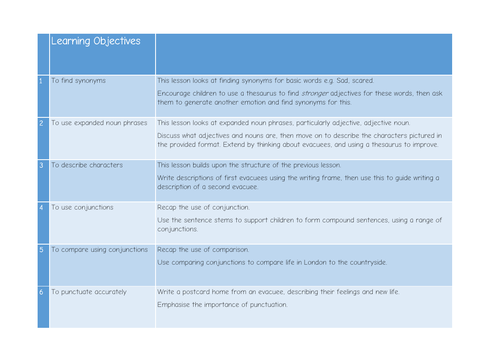37Uploads
69k+Views
47k+Downloads
History

WW2 comparing sources and reliability
An activity used with UKS2 to compare primary sources linked to Adolf Hitler. This could also be used in KS3.
Children are asked to compare different accounts and portrayals of Hitler, and to assess their reliability. This also links to the concept of propaganda.
Three different sets of questions are included for differentiation.

Example Poem linked to Romans
A poem based on the Romans to be used as a model text when teaching poetry. Contains examples of repetition, rhyme, alliteration, similes and metaphors. Suitable for KS2, or lower KS3.
A set of differented questions is also available.

Questions for Roman Poem
Differentiated questions linked to figurative language in a poem linked to the Romans.
Can be used as part of a series of work on poetry, figurative language or generally as part of a topic on the Romans.
Ideally suited to LKS2 but could also be used in UKS2.

Stone to Iron Age: comparison worksheet
A set of differentiated worksheets for pupils to compare life in the Stone Age to life in the Bronze age.
Ideally suited to LKS2 but could also be used with other age groups.
An ideal activity to explore change over time.

KS2 Roman artefacts historical enquiry worksheet
A worksheet created to introduce the topic of the Romans in KS2. This asks children to look at several artefacts discovered in the UK and suggest what they might be. Encourages inference and deduction skills.
Would be a useful replacement for classrooms where actual Roman artefacts are not accessible.

Life in the Stone Age - changes
A powerpoint and lesson activity exploring changes during the Stone Age period. This encourages children to explore the introduction of farming, and the wider impact this had on developing communities.
Ideally suited to KS2.

KS2 Parts of Circle - Penny Farthing
A worksheet that asks children to find different parts of circles, linked to the Victorians and Penny Farthings. Children must identify the radius/diameter when given certain information.
There is an inbuilt challenge to calculate the circumference.
This was originally used as a Year 6 lesson, but could be used with more able younger children, or KS3.

Stone Age - historical source deduction
A simple worksheet to encourage children to ask questions about historical sources. Contains pictures of three artefacts/pictures from the Stone Age, and questions about them.
Have used with Year 3 but would also be suitable for KS2 or lower KS3.

SEND/LA WW2 Description evacuation
A week of English activities linked to describing WW2 evacuees.
This unit of work was designed for a group of children working significantly below KS2 standards, so that they were able to successfully access work on the same topic as their peers.
Originally this was used in KS2, but this could also be relevant to SEND pupils in KS3.
An overview of the week is provided, as well as activities to complete.

Intro to the Stone Age (timelines)
Need some help with your Stone Age-Iron Age topic?
This is an introductory lesson on the Stone Age. Contains a powerpoint explaining the key periods of the stone age, and a multi-option timeline activity to document the chronology of the period.
This could be used to start a Stone Age-Iron Age topic in KS2, or for any other age group interested in this time period.

Into to Bronze Age lesson: making bronze
A powerpoint introducing the Bronze Age and an accompanying set of differentiated activity sheets.
Ideally suited to LKS2 but could be used across the primary age range.

Comparing European countries (Italy, UK, Poland)
A set of activities/worksheets to compare and contrast weather and climate in Italy, Poland and the UK. This involves interpretation of graphs and charts, some statistical work comparing data, as well as general geographical comparison and inquiry.
There are two sheets that compare Rome/UK, which would also fit into a topic on the Romans.

Geographical Enquiry - KS2 Romans
This is a lesson used to explore the question, “Why did Rome become the capital of the Empire?” It has links both to geography and history, and would be ideally suited to a topic on the Romans or on Italy the country.
Originally I used this in KS2. The main skills focus is on exploring how the physical features of a place affect human activity and economic growth.

Bronze Age: Archaeology and artefacts
How do we know about the Bronze Age if there are no written records?
This presentation introduces the Must Farm Bronze Age discoveries, and the basic archaeology used to find artefacts from the past.
Ideally suited to Year3/4, this could also be adapted for UKS2. Would also fit into a local study on East Anglia/the fens.

Parts of circle - whole lesson Penny farthing
The full lesson of my parts of a circle lesson, linked to Victorian Penny Farthings.
The PowerPoint goes through the different parts of the circle, as well as introducing pi and how to calculate the circumference.
Used in KS2, but also suitable for KS3.

Egyptians - Adding fractions KS2
A lesson looking at adding fractions and unit fractions, linked to the Egyptians.
Originally this was used in a mixed Y5/6 class to explore the concept of unit fractions, and adding fractions.
This includes a presentation, lesson plan and the worksheet used during this lesson. I have also included the fraction wall I used to support pupils. These can be cut up to help children understand the concept of adding unit fractions.
Bundle

Stone Age-Iron Age Pack
A pack of resources containing powerpoints, activities and worksheets about the Stone Age-Iron Age topic.
Includes artefact work, comparisons and links to archaeology. Supports historical enquiry and discussion.

















